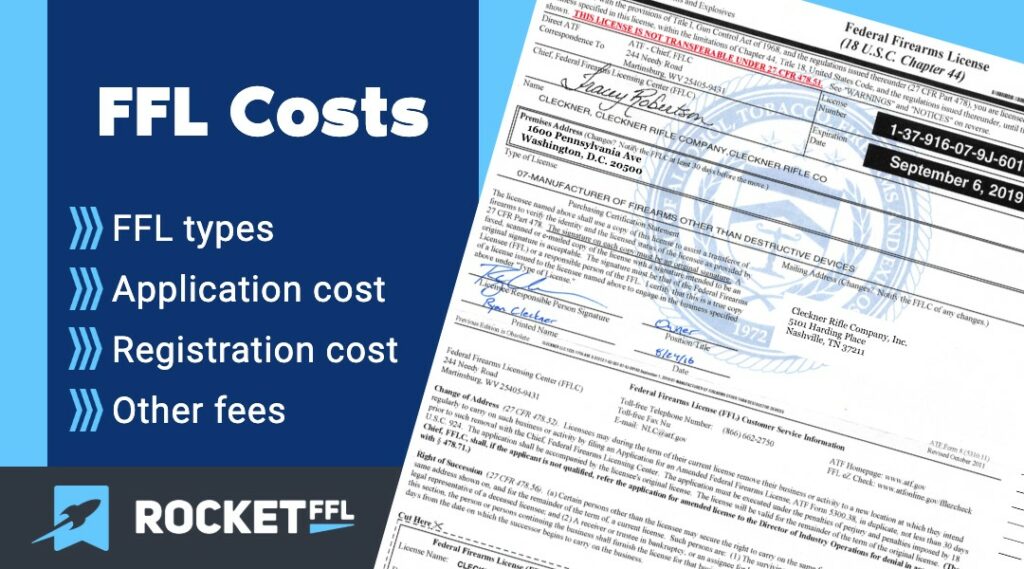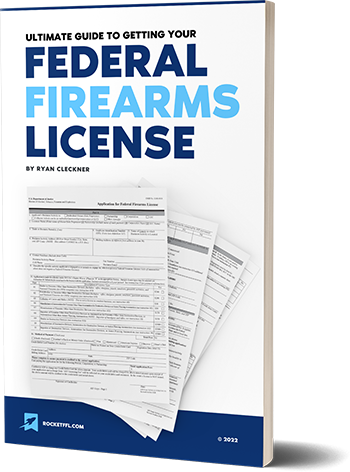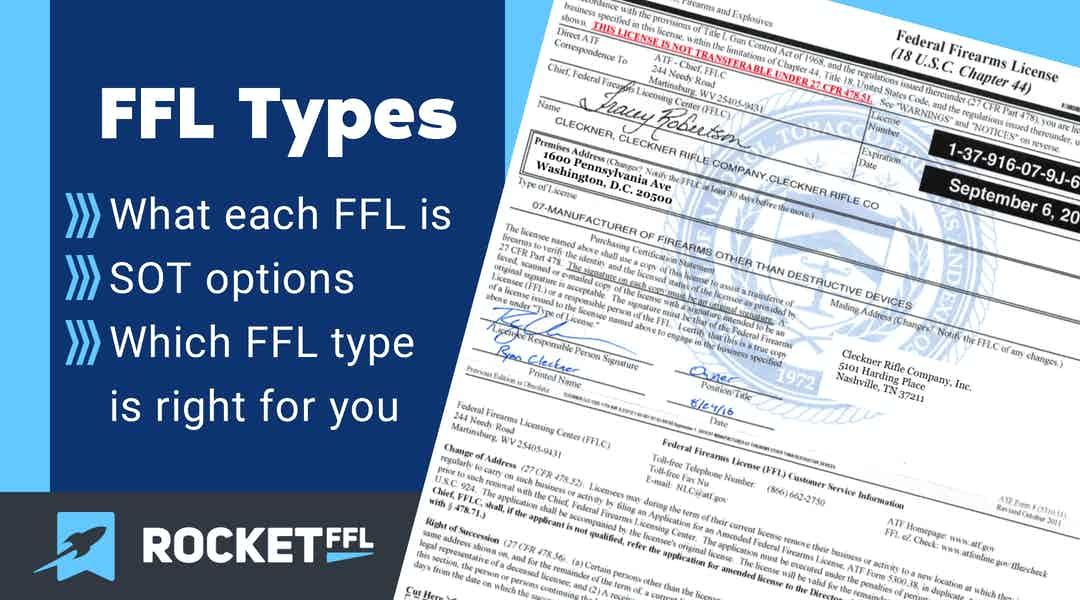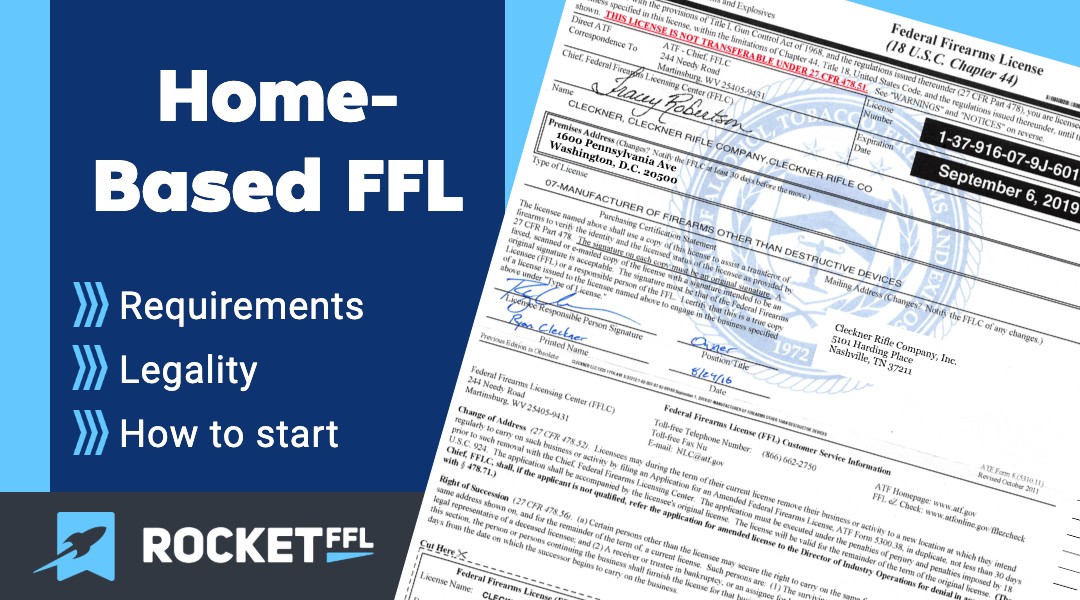The ATF has released new versions of seven revised FFL & SOT forms! We’ve got the latest versions here for you to download here. Below are descriptions, and the most up-to-date versions, of each of the following forms: All of these include revised mailing addresses and went into effect February 1, 2019. The ATF has […]

FFL License Cost [2024] – How Much is a Federal Firearm License?
If you’re thinking about getting a federal firearms license (FFL), one of the first questions you may have is how much an FFL will cost.
As a firearms attorney who’s represented and helped hundreds of FFLs against the ATF and who has helped thousands of people get their own FFL, I’m going to walk you through how much each type of FFL costs (including some cost you may no have thought of).
The cost of your license will depend on a few factors like which FFL type you choose, but the overall fee also includes other variables such as renewal costs and whether you want to work with NFA firearms (silencers, short barreled rifles, and more).
In this article, we’re going to cover:
Summary of FFL Costs
How much you’re going to pay to become a federal firearms licensee depends largely on what you want to do with your FFL.
For example, if you want to be an FFL dealer so that you can buy and sell guns, or even charge a transfer fee for each firearm transfer, then you will likely get a Type 01 FFL which costs $200 for the first three years and only $90 for each three year renewal.
However, if you want to manufacture guns, then the cost is $150 for the first three years and also for every three-year renewal thereafter.
Summary of each FFL License Cost by Type:
- Type 01 FFL – $200
- Type 02 FFL – $200
- Type 03 FFL – $30
- Type 06 FFL – $30
- Type 07 FFL – $150
- Type 08 FFL – $150
- Type 09 FFL – $3,000
- Type 10 FFL – $3,000
- Type 11 FFL – $3,000
There are three main FFL costs to consider:
- The initial FFL license application cost
- The renewal cost for your FFL
- Cost of registering as an SOT (if applicable)
A Type 1 Dealer’s license, the most common type of FFL, has a license cost of $200. The license is valid for three years. After that renewals for each subsequent three year period are $90.
The next most common type of FFL, the manufacturer FFL, has a cost of $150 every three years.
The cost for your initial Federal Firearms License, SOT registration, and other secondary costs can all depend on the FFL license type you want/need.
Let’s look at the types of FFLs first to help determine what you might need.
Which FFL license type should you get?
There are currently 9 different types of Federal Firearms Licenses (FFLs) – these range from your typical gun dealer/gunsmith FFL (Type 1) all the way up to firearm manufacturer and importer FFLs.
For a more information, see the article on FFL Types or, better yet, sign up for an online course to help you Get Your FFL.
For a simplified break-down of which type of FFL allows which kind of gun or ammunition activity (dealer, gunsmith, pawnbroker, curio and relic C&R collector, manufacturer, or importer) please see the chart below.
Note the columns, which help you to determine what each type of FFL will allow and which Class of SOT may be required. Only the Type 9, 10, and 11 FFLs can work with ‘Armor Piercing Ammunition’ and ‘Destructive Devices.’ Therefore, a Type 1 FFL can deal in standard firearms but not Armor Piercing Ammunition nor Destructive Devices. A Type 9 FFL, on the other hand, can.
FFL License Types
| FFL License Type | FFL License Purpose | SOT Class |
|---|---|---|
| Type 01 FFL | Dealer/Gunsmith of Firearms | 3 |
| Type 02 FFL | Pawnbroker/Dealer of Firearms | 3 |
| Type 03 FFL | Collector of Firearms | n/a |
| Type 06 FFL | Manufacturer of Ammunition | n/a |
| Type 07 FFL | Manufacturer/Dealer of Firearms and Ammunition | 2 |
| Type 08 FFL | Importer/Dealer of Firearms | 1 |
| Type 09 FFL | Dealer of Destructive Devices | 3 |
| Type 10 FFL | Manufacturer/Dealer of Destructive Devices | 2 |
| Type 11 FFL | Importer/Dealer of Destructive Devices | 1 |
Firearm Activity by FFL License Type
| FFL Type | Firearm Dealer | Firearm Manufacturer | Firearm Importer |
|---|---|---|---|
| Type 1 FFL | ✓ | X | X |
| Type 2 FFL | ✓ | X | X |
| Type 3 FFL | X | X | X |
| Type 6 FFL | X | X | X |
| Type 7 FFL | ✓ | ✓ | X |
| Type 8 FFL | ✓ | X | ✓ |
| Type 9 FFL | ✓ | X | X |
| Type 10 FFL | ✓ | ✓ | X |
| Type 11 FFL | ✓ | X | ✓ |
The two most popular types of FFLs are the Type 1 dealer/gunsmith FFL and the Type 7 firearm manufacturer FFL.
FFL Application Cost
As you can see in the chart below, each FFL lasts for 3 years.
Depending on which type you get, the FFL cost ranges from $30 to $3,000 for the first three years.
Let’s cover the costs from least to most expensive. When you’re looking at the application fees, don’t panic! I’ll show you below how you can make back the cost of your FFL, and more, at the end of this article with your first two firearms!
| FFL License | Application | Renewal | Years |
|---|---|---|---|
| Type 01 | $200 | $90 | 3 |
| Type 02 | $200 | $90 | 3 |
| Type 03 | $30 | $30 | 3 |
| Type 06 | $30 | $30 | 3 |
| Type 07 | $150 | $150 | 3 |
| Type 08 | $150 | $150 | 3 |
| Type 09 | $3,000 | $3,000 | 3 |
| Type 10 | $3,000 | $3,000 | 3 |
| Type 11 | $3,000 | $3,000 | 3 |
$30 application fee FFLs: These are the Type 3 and Type 6 FFL licenses. These are both unique because they may NOT be used for typical firearms transfers. The Type 3 FFL is called the “Curio & Relic Collector FFL” and is only used for . . . you guessed it . . . collecting curios and relics. Curios and relics are those firearms which meet one of the following criteria:
- Firearms which were manufactured at least 50 years prior to the current date, but not including replicas of such firearms; or
- Firearms which appear on the ATF’s official Curios and Relics List, which includes:
- Firearms which are certified by the curator of a municipal, State, or Federal museum which exhibits firearms to be curios or relics of museum interest; and
- Any other firearms which derive a substantial part of their monetary value from the fact that they are novel, rare, bizarre, or because of their association with some historical figure, period, or event.
The Type 6 FFL is the Ammunition Manufacturer’s FFL and may NOT be used for firearm transactions!
Be very careful here.
If you are an FFL, you must pay special attention to the FFL License Number to ensure that you are shipping a firearm to an eligible FFL. As you’ll learn in our article on license numbers, each number means something, and you must pay close attention.
$150 application fee FFLs: These are the Type 7 manufacturers license and the Type 8 Importers license.
These licenses are used to manufacturer or import GCA/Title I firearms. If you are also a Special Occupation Taxpayer (SOT), then these licenses may be used to manufacture or import NFA/Title II firearms also. In addition to their primary purpose, both of these licenses can also be used to deal (buy/sell) firearms.
$200 application fee FFL: These are the Type 1 firearm dealer/gunsmith license and the Type 2 pawnbroker license.
These are your most common store-front gunshop and ffl dealer licenses. Interestingly (to me, at least), these licenses cost more up front than a Type 7 manufacturer’s license which allows you to manufacture and deal in firearms (including conducting a ffl transfer where you can charge a transfer fee)
$3,000 application fee FFLs: These are the Type 9 dealers license, the Type 10 manufacturers license, and the Type 11 importers license.
These licenses are very similar to their counterparts with one major difference: all three of these licenses allow the particular activity to be conducted with Armor Piercing Ammunition (AP) and Destructive Devices (DD).
FFL Renewal Cost
Before 3 years is up, you’ll need to renew your FFL.
Just as the initial application cost for each FFL varied, so too does the renewal cost. Remember how the license to manufacture and deal (Type 7) was cheaper up front than the license to only deal (Type 1)? Well, that changes at renewal time.
The Type 01 FFL is so much cheaper to renew than the Type 07 FFL that is ends up being less money out of pocket by your fourth year in business. The Type 1 FFL will cost $290 in your fourth year whereas the Type 7 FFL will cost you $300 in your fourth year. In fact, the only Federal Firearms Licenses that have a renewal fee that is cheaper than their application fee are the Type 1 and 2 FFLs.
FFL Fees (Additional Costs)
Unfortunately, the license application fee may not be the only fee you’ll have to pay.
Depending on what you are going to do with an FFL, there may be some extra FFL fees.
SOT Registration Cost
If you plan to work with NFA firearms (silencers, short barreled rifles, machine guns, etc.), then you’ll need to register as a Special Occupational Taxpayer (SOT).
Depending on your FFL license type, you’ll either need to be a Class 1, 2 or 3 SOT. See the chart below to help determine which class of SOT registration each FFL requires.
The SOT registration is good for one year from July 1 to June 30. Therefore, if you start in this business in the first half of the year, you might be stuck paying for a full year’s registration and only get a couple months of use out of it because it’ll expire on June 30th.
The good news is that you’ll likely be in the “under $500k yearly sales” category below, so you won’t waste too much money. If you’re wondering more about what an SOT is, check out the article What is an SOT?.
If you’d like to get your FFL and become an SOT, sign up for your Guide to Get Your Own FFL and Become an SOT course bundle to save money!
SOT Registration Cost
| FFL Type | Under $500k | Over $500k | Class | Years |
|---|---|---|---|---|
| Type 01 | $500 | $500 | 3 | 1 |
| Type 02 | $500 | $500 | 3 | 1 |
| Type 03 | n/a | n/a | n/a | n/a |
| Type 06 | n/a | n/a | n/a | n/a |
| Type 07 | $500 | $1000 | 2 | 1 |
| Type 08 | $500 | $1000 | 1 | 1 |
| Type 09 | $500 | $1000 | 3 | 1 |
| Type 10 | $500 | $1000 | 2 | 1 |
| Type 11 | $500 | $1000 | 1 | 1 |
ITAR/DDTC Registration
If you meet the State Department’s definition of a manufacturer and manufacture any items on the USML,then you must register with the Directorate of Defense Trade Controls (DDTC) per the International Traffic in Arms Regulations (ITAR).
If you’re not sure about this, please consider taking the Guide to Get Your Own FFL to learn more.
The cost to register is $2,250 every year and the State department enforces this one – be careful! This used to be significant cost for FFL manufacturers, however, with the new ITAR rules, a manufacturer doesn’t need to register for non-NFA firearms.
Excise Tax Payments
If you’re a manufacturer and make 50 or more firearms per year, then you must pay 10-11% (depending on firearm type) of the firearm’s value as an excise tax.
This is steep!
It just isn’t worth making 51 firearms in a year. Keep it at 49 or go to 100 or more to make it worth your time.
The ultimate guide to getting your Federal Firearms License

How Much Does an FFL cost?
As you can see, it depends on what you want to do with your FFL.
If you want to be a dealer in standard firearms (non-NFA), then you can be up and running for three years as an FFL for $250.93 (that’s $200 to the ATF, $49.95 for your Get Your FFL course, and two postage stamps at 49 cents a piece).
If you want to be a manufacturer it’ll actually be cheaper for your first three years!
FFL Cost Breakdown
| FFL Type | FFL Purpose | First 3 Year Fee | Subsequent 3 Year Fee | Cost per year (year 1-3) | Cost per year (year 4+) |
|---|---|---|---|---|---|
| Type 01 FFL | Dealer | $200 | $90 | $67 | $30 |
| Type 07 FFL | Manufacturer | $150 | $150 | $50 | $50 |
If you want to work with NFA Firearms, you’ll be registering as an SOT and that will add $500 per year, but it let’s you make and/or buy and sell as many NFA Firearms as you want tax-free (no $200 tax per item).
If you’ve heard about ITAR registration and that is making you second-guess becoming a firearm manufacturer – worry not! The ITAR rules have changed and probably won’t apply to you in most cases. We cover this in our Get Your FFL Course.
DON’T LET THE MONEY DISCOURAGE YOU!
Remember, you are doing this to save and make money with firearms!
You can recover the cost of your FFL in as little as two firearms!
The MSRP for a Glock 19 is $599. The licensed FFL dealer cost for that gun from Lipseys.com is only $440. That means you can make/save $159 on only one Glock 19 – you’ll be able to off-set your FFL cost after your second gun!
Ok, you now know what the FFL cost of each type of Federal Firearms License is – are you ready to get your FFL?
Check out our article on How to Get Your FFL License for more info or sign up for our online start-up guide.
Type 01 FFL Cost
If you’re going to be a firearms dealer, you’re most likely going to get a Type 1 FFL.
The Type 01 FFL costs $200 for three years.
After that, license renewals will only be $90 for each three year period.
As a licensed dealer, you’ll be able to have your own gun shop where you can buy and sell firearms (even from your own home). Also, you can make some side money by receiving a firearm shipment for someone and charging them an ffl transfer fee for the transferred firearm.
With calls for legislation for universal background checks, as an ffl holder, you can even make money charging for a private party transfer (to cover the NICS background check required by the Gun Control Act) even a storage fee if someone needs you to hold onto a gun for them.
If you want to buy and sell NFA firearms, like a silencer, short barreled rifle, or machine gun instead of just standard firearms like a rifle, handgun, or shotgun, you’re also going to want to become an SOT which will cost $500 per year (but it saves the $200 per NFA item tax).
Type 07 FFL Cost
If you want to make guns (and also be able to sell them), the you’ll likely want a Type 07 FFL.
The Type 07 FFL costs $150 for three years.
After that, license renewals will also be $150 for each three year period.
As a licensed manufacturer, you’ll be able to make firearms and sell them to other FFLs or even to a customer as a buyer at your licensed location.
If you want to make and sell NFA Firearms, you’ll need to become a Special Occupational Taxpayer (SOT).
FFL Cost FAQ
An FFL License costs between $30 and $200 for 3 years.
The fee for an FFL is the original license cost (the most common is $200 for the first three years) plus any additional fees like SOT Registration.
A Type 01 FFL costs $200 for the first three years and $90 for every three year renewal afterwards.
A type 07 FFL costs $150 for the first three years and $150 for every three year renewal afterwards.
An FFL license typically costs between $30 and $200 for the first three years.
Getting an FFL has some extras fees in some situations – if you make enough firearms, there can be excise tax payments, if you make NFA Firearms there is an ITAR registration fee, and if you’d like to become an SOT to work with NFA Firearms, there’s an annual registration fee.
The most common type of FFL, for business, is a Type 01 FFL. You can learn more about FFL Types here.
Recommended Posts
122 thoughts on “FFL License Cost [2024] – How Much is a Federal Firearm License?”
Leave a comment

![New ATF Forms [2019]](https://rocketffl.com/wp-content/uploads/2019/02/New-ATF-Forms-1.jpg)


Is there an ITAR tax/fee on a type 7. $2500 per year?
No. Just having a Type 07 does not require a fee. On the other hand, the fee can apply without a Type 07. We discuss this in our courses.
So if my understanding is correct if I plan to build custom rifles/pistols for customers an 07 is needed to perform this type of work and I will be required to pay the $2250 to the DDTC
No. Standard rifles and pistols are not covered under ITAR.
I would like to start manufacturing shotgun ammunition with a type 7 FFL. Will I need to register with the ITAR/DDTC if i am only manufacturing ammunition? And, will I incur the excise tax for ammunition manufacturing?
This is partially covered in our Get Your FFL course and will be addressed better in our soon to come ATF Compliance course and Import/Export Course.
What about an FFL in California? I am planning to do the course but want to make sure that I can get an FFL in the state of California. Eventually I want to become a SOT as well.
Our FFL course can help you get your FFL in California.
I recently received my Class 3 FFL in CA and am currently applying for my COE.
What business type should I select to ensure I am able to receive and transport ammunition from out of state?
You need to select whatever business type you have for your FFL. I assume you mean that you got an FFL (maybe a Type 01) and also become a Class 3 SOT? Effectively, it’s too late to be making business-type decisions as you already have an FFL in the business name. And, if this is a new business you’re making, then the new business doesn’t have an FFL. If you’d like some help getting this sorted out, perhaps our Get Your FFL course can help to make sure things are set up the right way.
Ryan, Do you know what FFL Level is required in California with the new ammunition laws restricting consumer purchases? Before 2018 a consumer could order from out of state ammo dealers. Now an out-of-state supplier sends it to an FFL for consumer to acquire.
I believe beginning in 2019 these transactions (acquisition & treansfer to consumer) must be reported to a state agency.
So curious if a Type 1 FFL will suffice?
Thank you. I just purhased the initial rocket bundle – good so far!
Will
Thanks for the great info. I believe I would be a class 3 but not sure. I am a gun collector but not relics. Whenever I buy a gun online, it cost beteween $30-$50 to transfer it. That looks like the one year cost for an FFL. If f I sell a gun, I sell it back to a gun shop. Can I get an FFL to buy guns direct?
Absolutely! You can order guns at dealer cost straight to your home if that’s where you get your FFL.